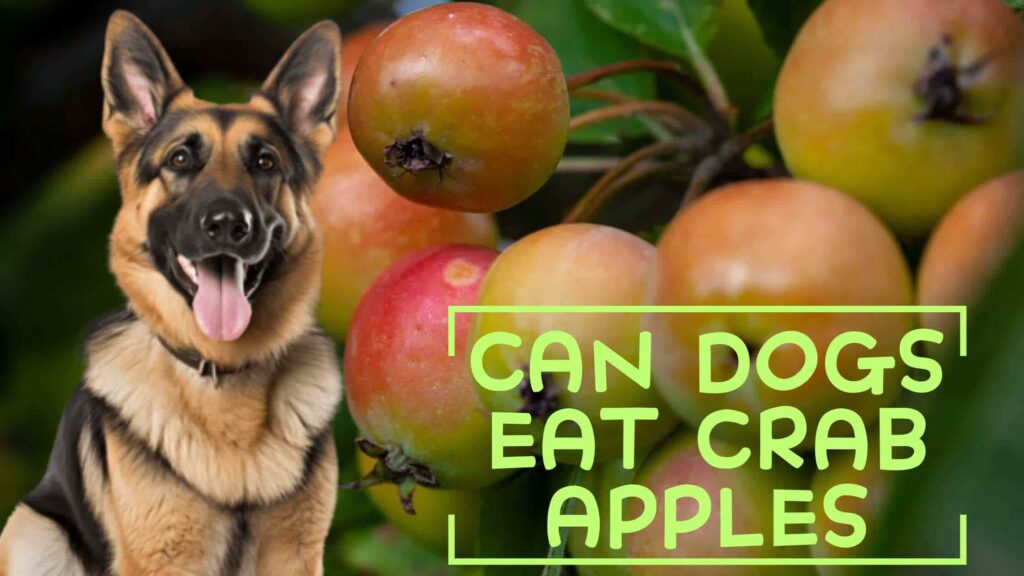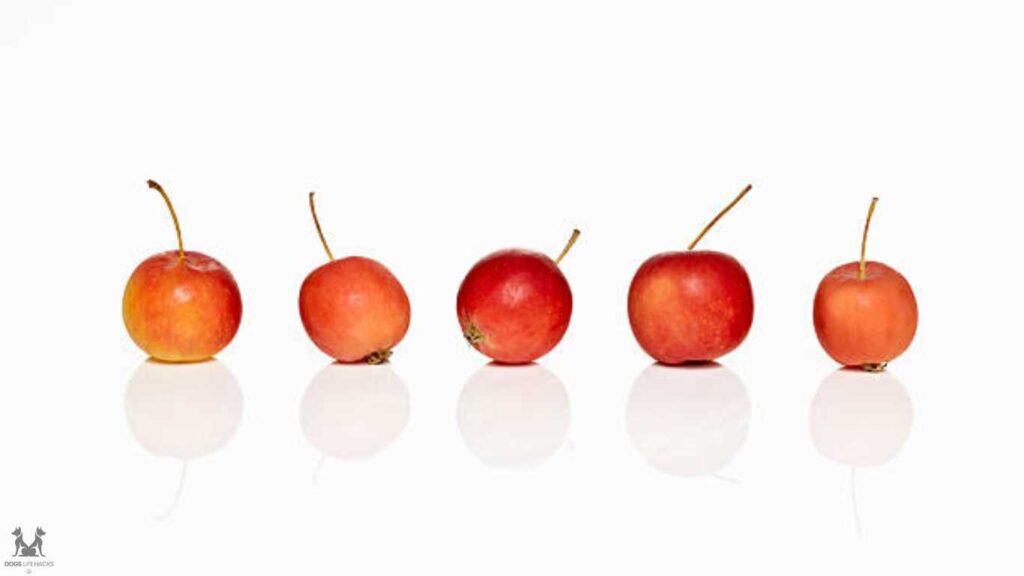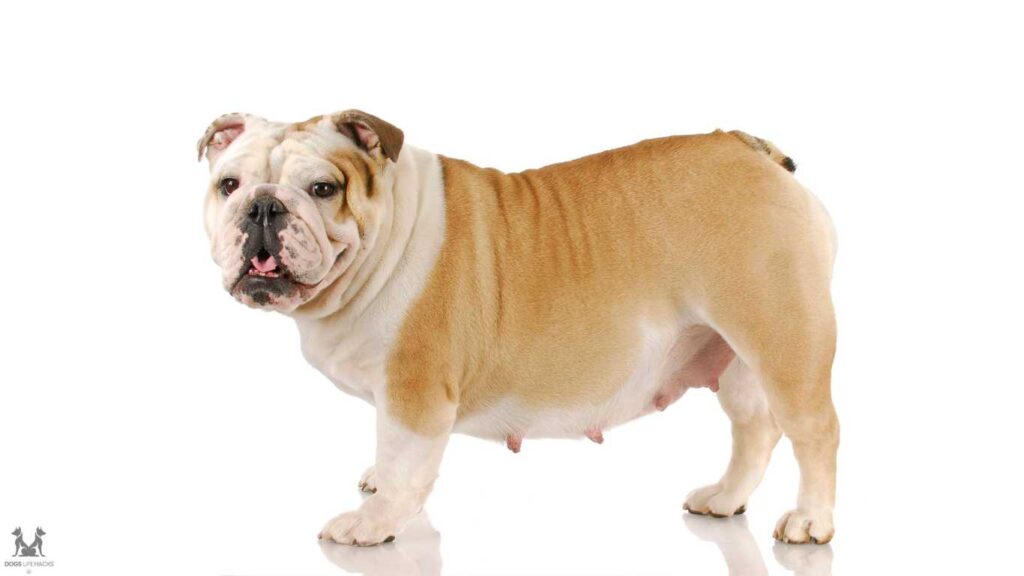Can Dogs Eat Crab Apples? Safe Snack or Dangerous Treat?
Dogs are fond of eating apples, which is a good diet for dogs, but dog owners are always worried about whether other varieties like crab apples are good or bad for their dogs. So, can dogs eat crab apples?
After research and discussion with vets, we learned that crab apples are poisonous to dogs. In this comprehensive article, we are going to discuss about cons, pros, and every aspect you need to know about crab apples.

Nutritional Content of Crab Apples
Crab apples look not very different from regular apples, but their health effects on dogs are not very positive. Despite these fruits containing vitamins A and C, diet fiber, antioxidants, and other nutrients, the dangers outweigh the benefits of ingesting these fruits by your dog.
As for dogs, there is little nutritional benefit the animal can gain from the crab apples, in terms of nutrition. The vitamins that are contained in crab apples can be found in other products that are considerably safer for dogs and included in their diet, for example, apples without seeds or blueberries. The fiber, however, makes them relatively healthy provided one does not overindulge in the toxic portions of the fruit.

Also, though the antioxidants should help with the immune system, there are many better ways to increase this for your dog. This knowledge helps to emphasize that though these fruits are healthy their consumption is not desirable for dogs due to the threats sounding from their nutrients.
Can dogs eat crab apples? Recognizing Hazards
Even though crab apples might seem to be an excellent and delicious meal for your dog, they have several features that contain definite risks for your pet’s health. One of the main risks is connected with the toxicity of some parts of the crab apple for dogs.
The seeds, stems and leaves contain cyanogenic glycosides which liberate hydrocyanic acid on consumption. They include cyanide which is lethal and can provoke severe health issues affecting dogs even if they ingest a small quantity of it.
It is also worth noting that the fruit itself is potentially lethal if taken in the right amount by a human being. Crab apples are highly acidic and their consumption can bring about stomach upsets including stomach ache, vomiting, and diarrhea.
More serious effects of crab apple poisoning are respiratory distress, convulsion, and in extreme cases, death.
Symptoms and First Aid for Crab Apple Munching

Knowing the signs of crab apple poisoning in dogs and its discovery after their consumption will be the optimal solution to the problem. Failing to get early diagnosis and treatment means that your dog may spend several days in the sick bay and recover.
Common Symptoms to Watch For
Vomiting and Diarrhea: These are usually the manifestations at the early stages that something is amiss. Crab apples may be too acidic, and this means that they will irritate your dog’s stomach lining. This is why your dog will exhibit these symptoms.
Excessive Drooling: This is a manifest indication of the start of nausea or the development of complicated issues.
Lethargy and Weakness: However, signs of cyanide poisoning, which is usual in seeds, stems and leaves are signs of excessive fatigue or weakness in your dog.
Difficulty Breathing: Cellular respiration is impaired by cyanide with subsequent respiratory failure.
Seizures or Tremors: In some complications, the toxins interfere with the nervous system and can cause your dog to have seizures.
Immediate First Aid Steps
Remove Access: Remove any remaining crab apples immediately from your dog’s realm so that he does not eat more of them.
Check for Symptoms: It is advisable to observe your dog and detect some of the symptoms that have been elaborated above.
Induce Vomiting: As a home remedy, if the ingestion was within the last hour and your dog is not very sick, it may be advisable to make him or her vomit to eject the crab apples. But this should be done under the supervision of a veterinarian although it plays a major role in the reproductive process.
Hydration: Dogs should also not be deprived of the most essential component for survival, which is fresh and clean water. It is useful to reduce the concentration of toxins and to calm the stomach.
Contact Your Veterinarian: It may not be severe most of the time but you need to seek the services of a vet. They can give advice and when referring to your dog, may advise that your dog be brought in for observation or treatment.
Understanding and Treating Crab Apple Toxicity
0Crab apple poisoning in dogs is a severe health complication that is brought about by the consumption by your dog of some parts of the crab apple tree such as the seeds, stem, or leaves of the tree. These parts include cyanogenic glycosides which in contact with enzymes decompose to form cyanide a poisonous substance that halts cellular respiration hence impairing the use of oxygen by body cells.
How the Body Reacts
If a dog eats the toxic parts of a crab apple the body will attempt to get rid of the toxins in any way possible. This may lead to nausea vomiting and finally diarrhea as the body tries to eliminate the toxins. Nevertheless, if the quantity of cyanide entering the bloodstream increases critically, it inhibits the ability of transport in red blood cells resulting in breathing problems, tachycardia, and in extreme cases, seizures or coma.
The level of toxicity varies with the amount of crab apples consumed together with the size of the dog. Pomeranians and other toy breeds are more susceptible since less cyanide is needed to injure the dog. The good news is that if the early symptoms are detected, then much can be done to slow the evolution of the clinical signs and the severity of the harm that they cause to your dog.
Treatment Options
Immediate Veterinary Care: And if you have strong reasons to believe that your dog has ingested dangerous parts of crab apples it is high time you sought the services of a vet. If it was taken recently, your vet may make you induce vomiting while, if the toxins have already reached the digestive tract, your vet may give you activated charcoal to help the toxins pass through your system.
Oxygen Therapy: If due to cyanide poisoning your dog’s ability to breathe has been impaired then you can administer oxygen to help the respiratory system.
Intravenous Fluids: These can also aid in washing out the toxins and make the pet drink more water, thus the load on the kidneys and other central organs is decreased.
Antidotes: For serious cases, additional prescription counter-ingredients such as sodium thiosulfate and hydroxocobalamin can be used to counter the effects of cyanide.
Long-Term Effects of Crab Apple Toxicity
It is obvious that eating crab apples is poisonous to dogs, but it is equally crucial to know the long-term impacts of the poisons gained from the fruit on your dog’s body. The reactions may not stop at the time the dog has eaten crab apples or the time they feed on the toxic parts of the fruit but may follow as consequences when the dog has not been treated immediately.
Potential Long-Term Health Issues
Organ Damage: Chronic effects resulting from exposure to the toxins in crab apples including cyanide affect the liver and kidneys. These organs are generally responsible for removing poisons from the system; should they get embarrassed they will be irreversibly damaged and the result can be prolonged health issues.
Neurological Issues: In cases in which cytotoxicity is manifest in the nervous system and the poison has damaged nerve tissue, permanent neurological damage may occur in the animal.
This could be in the form of motor fluctuations such as tremors, weakness, or seizures many years after the poisoning had occurred.
Respiratory Problems: Should the poisoning of the lungs have occurred, your dog may experience long-term effects similar to respiratory distress syndrome, which is a shorter breath or less stamina from a run. This is because the lung tissue or the respiratory system as a whole may receive damage.
Monitoring and Care After Exposure
As much as possible corpses should be avoided; when a dog recovers from ingesting crab apples with toxic juices, it is advisable to continue checking up on the animal.
Periodic check-ups should be made with the vet because some organs may still be affected permanently. Thus, your vet can recommend a blood panel, a urine test, or any other test to determine the operation of the organs in your dog.
In addition, giving a proper diet filled with foods that contain antioxidants and other components may also fix any cell damage in the canine’s body and improve its general health as well. Dietary supplements aimed at improving liver and kidney functions could probably also be prescribed.
Are Crab Apples Poisonous to Pregnant or Lactating Dogs?

Surgically manipulated bitches are more vulnerable to diseases, stress, and environmental impacts, especially pregnant and lactating females. In the case of crab apples, the dangers are even greater for these dogs, so one has to be even more careful.
Specific Concerns for Pregnant Dogs
Being pregnant, a dog’s body is oriented to produce puppies and as a result, is more sensitive to poisons. Consumption of crab apples may be very dangerous to the life of the mother and her unborn puppies when taken especially the toxic parts of the apples such as seeds, stems, or leaves.
Some types of glycosides present in the crab apples are cyanogenic and these compounds hinder the process of cellular respiration thereby denying oxygen to both the Pregnant woman and her developing fetuses.
This may lead to situations where pregnancy might be terminated, the puppies may develop certain abnormalities or the mother might die if the condition is left unattended.
Specific Concerns for Lactating Dogs
And that is not all; even lactating dogs are not exempted from these perils. The stress of nursing can demineralize the bones of a dog, and tiny toxins that have built up in the dog’s body can be more difficult for the dog to expel.
These toxins may in one way or the other affect the puppies since the lactating dog may have ingested the crab apples and the toxins could be transmitted through the milk to the newborns.
The cases of acute cyanide poisoning are critical especially in new-born puppies since their bodies are not capable of handling contingencies and such toxins.
Extra Precautions to Take
For the safety and well-being of pregnant or lactating dogs, it is best to deny them access to crab apples or the areas where they can be found. One of them is washing the yards frequently and avoiding taking walks with your dog in crab apple tree areas frequently infested by these fruits.
In the case that you find your dog having contacted crab apples in some way, you need to seek the help of a vet since the consequences of the ingestion are very dangerous to the dog’s life.
What Should You Do If Your Dog Eats Crab Apples?

If your dog has consumed crab apples it is important to try and reduce the effects as much as possible. Though it may not harm your dog if ingested in small amounts, there are side effects that your dog can suffer from, especially if it consumes the poisonous parts of the fruit.
Step-by-Step Guide on What Actions to Take
Assess the Situation
Lake-Leber explains that you should first establish as to how much and which portions of the crab apple your dog ingested.
The seeds, stems and leaves are the most poisonous parts of the tree so it is important to determine whether any of these parts were consumed either deliberately or accidentally.
Monitor for Symptoms
When using this remedy ensure your dog is closely monitored since some of the possible side effects include vomiting, diarrhea, lots of drooling as well as lethargy. If your dog shows any of these signs, then you can be sure that the toxins are ailing your dog.
Contact Your Veterinarian
Do not assume everything is alright even if your dog is OK at first, please call the vet for consultation. Pass on as many details as possible, quantity of crab apples consumed, and any symptoms that your dog is displaying.
Induce Vomiting (if advised)
It is advisable to induce vomiting if the ingestion is recent and your veterinarian approves it, the toxic substance that has been ingested has to be expelled from the body of your beloved pet.
However, this should only be done under the supervision and counsel of a professional since vomiting can sometimes be dangerous and counterproductive.
Provide Fresh Water
Always provide your dog with free access to clean water. This may assist to clear the toxins as well as decrease the possibility of dehydration if vomiting or diarrhoea happens.
Visit the Veterinarian
Subsequently, based on the severity of the observed condition, one may be advised by the vet to bring your dog in for an examination. They could carry out tests to check the level of toxicity and give treatments such as charcoal, fluids, or any other remedy required.
Follow Up Care
As you deem fit, take your pet to the response quickly as may be prescribed by the vet for further handling. This may include observing for delayed signs in your dog and taking him for a check-up to ascertain whether any serious damage has been caused.
Treatment for Crab Apple Toxicity in Dogs
Sometimes dogs eat parts of the crab apple tree that are poisonous and if your dog is suffering from such a condition, you must seek treatment at once.
Toxicity from crab apples can normally present with only mild gastrointestinal signs, up to acute poisoning, depending on the quantity ingested and the size of the dog.
Veterinary Treatments and Interventions
Inducing Vomiting
When the ingestion was not a long time ago, your veterinarian may decide to make your dog vomit to expel the toxic substance before it gets absorbed in the body. This is normally done several hours after the intake of the drug and it is more efficient if done as soon as possible.
Activated Charcoal
Activated charcoal may be taken to neutralize the toxins in the gastrointestinal tract so that the toxins may not be absorbed in circulation. This treatment is given in case of poisoning and it is usually very effective when administered early.
Intravenous Fluids
I.V. fluids can also be employed to improve your dog’s urinary system to help eliminate toxins within the body. This also aids in minimizing the chances of your dog getting dehydrated if at all it was vomiting or having diarrhea due to the poison it ingested.
Oxygen Therapy
In the case of acute cyanide poisoning additional actions are possible, including oxygen therapy may be used. Cyanide also inhibits oxygen utilization by the body, and hence administering oxygen helps to manage some of the effects as well as protecting organs.
Specific Antidotes
In case of poisonings with cyanides, your veterinarian may use specific cleansers, which are sodium thiosulfate or hydroxocobalamin, to block the toxic effects of cyanides.
Hospitalization and Monitoring
In severe toxicity, your dog will require hospitalization and when we say hospitalization it entails close supervision and supportive care.
This helps in detecting any possible complications that may be experienced by the dog and this means that the dog will be well compounded as it heals.
Home Remedies and Supportive Care Options
Hydration: Make sure your dog drinks lots of water to avoid dehydration more so when they are experiencing lots of diarrhoea.
Diet: For example, suggest a patient eat plain boiled chicken and rice to treat a complaint that has affected their tummy. Do not give any treats, or food that will only make the digestion worse.
Rest: Make sure your dog does not get stressed or actively physically doing things like running around. Do not engage your dog in strenuous activities until you talk to the veterinarian and they clear your dog.
Personal Experience “Can Dogs Eat Crab Apples”

Relating one’s experience with toxic crab apples to other people, especially to the owners of the affected dogs will be more timelessly helpful on their side. Below is presented the case-based real-life experience that details the effects of crab apple poisonous and how to manage it.
A Case Study
Max was a fun-loving Labrador Retriever who enjoyed running around his backyard. One day in autumn Max was running after squirrels and he saw a few crab apples on the ground. He was eager to investigate the matter and so chewed some of these sour fruit and seeds, stem and leaves.
It was within a few hours that Max started expressing discomfort. His owner Sarah realised that the cat was vomiting and looked extremely weak. Frustrated, Sarah rushed to her phone and called her veterinarian to describe what she saw. That is when the vet told Sarah that she should bring Max for a check-up as soon as possible.
On getting to the clinic the vet examined Max and informed us that he must have eaten the toxic samples from the crab apples. Activated charcoal was administered to Max at once so that any more toxins could not be absorbed into his body.
He was given IV fluids to help his kidneys and to cleanse his body from toxins. Max also had to undergo oxygen to ease his breathing since he was receiving a treatment of cyanide from the crab apples affecting his respiratory system.
After the interventions of the vet, the following few days were relatively favorable and Max showed a lot of improvement. Closely observed was he, and on a milk diet to commence nursing his inside. It was a relief to see Max back to his playful self and learn something that crab apples have risks associated with them.
Lessons Learned and Advice for Other Pet Owners
Be Vigilant: One should always be careful of the kind of plants and fruits when in the compound or during a walk. Even plain crab apples are not suitable for dogs; on the contrary, their consumption poses many serious threats.
Prompt Action: In case you notice signs of poisoning or have a strong feeling that your dog took toxic substances there are some measures to take. It is therefore important to quickly consult your veterinarian in the process of your dog’s healing.
Prevention is Key: Lightproof the house and exclude plants and fruits that may be carcinogenic. Use your yard often and remove the fallen fruits to prevent kids or animals from taking them mistakenly.
Educate Yourself: It is crucial to know the dangers of the usual plants and fruits used in gardening so your pet canremain safe from possible sicknesses.
Can Dogs Eat Apples & Apple Skins?
In general, while talking about crab apples it might be better to refer to regular apples because the latter is much more familiar to most dog owners. Awareness of these differences is therefore useful, in helping one make better decisions for their pet’s sake.

Comparison Between Regular Apples and Crab Apples
Nutritional Value
Regular Apples: In most cases, apples are non-toxic to our pets and will benefit their health in one way or the other. Electrical blueberries are particularly a rich source of vitamins A and C, fiber, as well as antioxidants. When given in moderation these nutrients can help a dog’s overall health.
Crab Apples: Crab apples also contain some vitamins and antioxidants like vitamins C and A, and antiradical activity, however, their high acidity and potential toxins, especially in seeds stems, and leaves, Crap apples are not good for dogs. Although crab apples contain vitamins and minerals required in the body, their toxic components justify the risks incurred by them.
Safety of Consumption
Regular Apples: Dogs can consume the pulp or meat part of the normal apples but the seeds and the core should not be given to the pet. Both the seeds and certain elements of apples contain so-called cyanogenic glycosides, similar to those present in crab apples, which can produce cyanide when metabolized. The normal apples should be administered sparingly to prevent stomach upsets.
Crab Apples: Seeds and stems of elm, all parts of crab apples including stem, seed, and leaves should be avoided. Even the fruit itself which is relatively less dangerous is not good for the health of dogs mainly because of its sourness and likelihood to upset their tummy.
Safe Practices “Can Dogs Eat Crab Apples”
Remove Seeds and Core
Apples are a great snack for a dog, but they should be given with seeds or the core of the apple is removed first. The seeds contain toxins, which are, in fact, cyanide; the core of an almond can cause choking.
Moderation is Key
Have apples in easily chewable portions to avoid young children swallowing them whole. By having too much of it, one is likely to experience some side effects which include stomach upsets and loose bowel movements.
Monitor for Reactions
As with any new kind of food, one should monitor one’s dog for signs of discomfort when introducing apples into a dog’s diet. In case any of the symptoms, which are not normal, are observed one should consult their veterinarian.
Alternative Fruits
However, if you are seeking ways of serving fruits to your dog, you should resort to other types of fruits as apples can be dangerous for your dog as for blueberries, bananas, or strawberries. These fruits reach the body without the typical adversities and can offer comparable nourishment.
Preventing Crab Apple Mishaps
Preventing crab apple incidents is thus a question of preventing such fruits from becoming a problem as it would mean preventing possible health challenges. If some measures are adopted, your dog will stay protected and will not eat crab apples by any chance.
Tips for Dog Owners to Prevent Accidental Ingestion
Regular Yard Maintenance
Clean Up Fallen Fruit: Crab apples are messy and what falls on your yard such as flowers should be picked up often. This will assist in preventing your dog from discovering them or taking a bite of them.
Remove Crab Apple Trees: In case it is possible, consider relocating crab apple trees from your yard. This is the optimal strategy as regards the complete exclusion of such fruits from your furry companion’s life.
Secure Your Property
Fencing: Make sure you have a well-fenced compound so that your dog does not stray away into an unauthorized compound that may contain crabapple trees.
Supervised Outdoor Time: About going outside, be sure to monitor your dog well so that they do not get a hold of such things as crab apples.
Safe Alternatives to Crab Apples for Dogs
Healthy Fruits
Carrots: It is quite safe and healthy for these dogs in their preference of the great alternative. They have minimal energy value and massive amounts of fibers;
Blueberries: This fruit is loaded full of antioxidants, and vitamins, which will be a great source of nutrition for your dog without posing any threats.
Pumpkin: Boiled or steamed pumpkin is easy for the dog’s digestive system and is harmless to their health.
Dog-Specific Treats
Commercial Dog Treats: Select a high standard, recommended by a veterinarian type of dog biscuit that will be good for the general health of your pet.
Homemade Treats: It is possible to prepare yourself some species-safe treats, using such ingredients as, for instance, sweet potatoes or apples (without seeds and core).
Conclusion of “Can Dogs Eat Crab Apples”
To sum it up, even though you might deem crab apples as harmless components of your yard’s flora, they stand as severe threats to your dog’s well-being. Knowing and identifying some risks that are inherent with the product and the impact it can have if ingested by pets is important in avoiding such incidences from reoccurring.
Risks of Crab Apples: Crab apples have toxic parts, or seeds, stems, and leaves and it has been reported that it is dangerous for the health of dogs. Although its pulp is comparatively less poisonous, its consumption may lead to a variety of gastrointestinal ailments owing to sourness.
Symptoms of Toxicity: Symptoms of crab apple poisoning include vomiting, diarrhea, undue tiredness, and breathing problems. Early diagnosis and intervention are vital since the moment that a disease is diagnosed determines the way it will be treated.
Immediate Actions: Whenever you realize that your dog is suffering from diarrhea and/or vomiting after consumption of crab apples, it is advisable to contact your veterinarian. Indications such as vomiting and subsequent remedies such as the use of charcoal and intravenous fluids can reduce the impact of toxicity when done early enough.
Long-Term Care: Check on the health condition of your dog after having a hitch with crab apples. Monitor for complications and also look for any manifestations that would show that the effects experienced are long-term and seek treatment when necessary.
Preventive Measures: Preventing the possible, accidental ingestion of toxic substances can be accomplished through proper yard maintenance, proper security measures, and proper sensitization of the public as well as oneself. Choosing safe fruits, and the right quality dog treats guarantees your pet is in good health and is always happy.
Final Advice for Dog Owners
Keeping your dog safe from crab apples and other potential hazards requires vigilance and proactive measures. By staying informed about the risks and taking appropriate actions, you can protect your pet from the harmful effects of toxic plants and ensure their well-being.
With these strategies in mind, you can enjoy peace of mind knowing you are taking the necessary steps to keep your dog safe and healthy.
Feel free to review the entire blog post and let me know if there are any additional details or revisions needed!
FAQs About “Can Dogs Eat Crab Apples”
Are crab apples toxic to dogs?
Crab apples have a potential for being toxic and this mainly stems from the presence of cyanogenic glycosides, particularly in the seeds of the fruit as well as in the core. And while a man might just cough out a couple of seeds, dogs are not nearly as picky. If your dog consumes these compounds, your dog is in trouble because these compounds result in cyanide poisoning, which affects the oxygen delivery system.
Do any animals eat crab apples?
Some of the most common birds found in the trees include cedar waxwings, Robins, cardinals and at times Squirrels occasionally visit these trees. What a delight it is to sit down and watch them open and blossom with gorgeous wild birds feeding on the berries.
Are crab apples poisonous to dogs in ASPCA?
Crab apples and all species of apples contain cyanide in all parts of the plant except in the actual fleshy part of the apple. Cyanide interferes with the enzymes involved in the transporting of oxygen and inhibits the ability of cells to utilize the oxygen in the blood flow which makes fallen apples lethal for pets.
Why can’t dogs eat crab?
Yes, they are allowed to feed their dogs with crab meat in most instances but always in moderation. However, there is a problem – there is a possibility of an allergic reaction to crab meat and this food is also rich in iodine, a chemical which some dogs are especially sensitive to. All the same, it is prudent to be careful and avoid overindulging your dog with crab meat although the same is not considered poisonous.
Why don’t people eat crab apples?
Crab apples are intended to be consumed, and it is safe for people to take the flesh of this fruit. But like other apples, these seeds contain a toxic element which when consumed can be lethal in that it turns to cyanide. Oh no, but do not worry, these apples are fine to eat so long as you do not consume the seeds and core.
Related Articles
